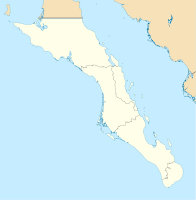Guerrero Negro
| Guerrero Negro | ||
|---|---|---|
|
Coordinates: 27 ° 58 ′ N , 114 ° 3 ′ W Guerrero Negro on the map of Baja California Sur
|
||
| Basic data | ||
| Country | Mexico | |
| State | Baja California Sur | |
| Municipio | Mulegé | |
| City foundation | 1957 | |
| Residents | 13,054 (2010) | |
| Detailed data | ||
| height | 3 m | |
Guerrero Negro ( Spanish for "black warrior") is a Mexican city with around 13,000 inhabitants (2010 census) in the state of Baja California Sur , about two kilometers south of the border with the state of Baja California directly on Mexican federal highway 1 .
Administratively, Guerrero Negro is the largest city in the municipality of Mulegé .
What is striking about the cityscape is that the center (Centro) lies entirely in the southwest of the new town (Nuevo Guerrero Negro) with the streets that are predominantly at right angles to one another. The federal highway 1 runs through traffic-calmed on the eastern edge of the city and the main feeder road to the center forms the southern edge of the new town. A football stadium is located north of the center and west of the Neustadt.
geography
Guerrero Negro is located at about nine meters above sea level in the northern foothills of the Vizcaíno Desert and borders the Reserva de la Biósfera El Vizcaíno protected area of the Pacific Bay of Bahía de Sebastián Vizcaíno , a UNESCO World Heritage Site since 1993 .
Surname
Guerrero Negro - Spanish for "black warrior" - is derived from a US whaling ship from Boston called the Black Warrior , which was stranded fully loaded here in Guerrero Negro in 1858.
traffic
Airport: A public airport with a 2,200 m long asphalt runway was built next to federal highway 1 about six kilometers north of the city to make it easier to reach. The IATA airport code is GUB.
tourism
Between January and March, a particularly large number of tourists come to the laguna Ojo de Liebre ("eye of the hare ") to the south-west to watch the gray whales that come here to calve . Every year in the first half of February, the city celebrates the great festival of the annual arrival of the gray whales. Whale watching instead of whaling is now the motto.
Other attractions include the estuary and the marshes, where over 200 different species of birds live, the caves in the Sierra de San Francisquito , over 300 prehistoric petroglyphs as well as the islands and bays near Guerrero Negro and finally the salt production with the huge white sea salt extraction basins .
Industry
Sea salt extraction: With around seven million tons of annual production, this saltworks (a stock corporation) is the largest in the world. It was founded in 1957 - this also led to the emergence of the city of Guerrero Negro - by the American Daniel K. Ludwig (number 1 in the first Forbes list of the 400 richest Americans from 1982) on the banks of the Laguna Ojo de Liebre and offers meanwhile work for over a thousand people. Since 1973 the Mexican state owns 51%, Mitsubishi holds the remaining 49% .
